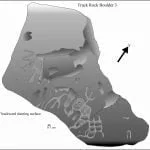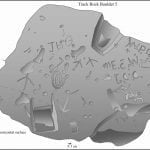
As a major portion of its professional services to the U.S. Forest Service in the year 2000, Stratum Unlimited, LLC prepared graytone renderings of the six main boulders at Track Rock Gap. These renderings will be of incalculable value to the citizens of the United States in the future. Because they remained exposed to the elements, the petroglyphs deteriorated at an accelerating pace in the early 21st century. Acidic rainwater is the primary culprit. The renderings of the Track Rock petroglyphs are presented on a website sponsored by the USFS.
Johannes Loubser provided only generalized interpretation of the images on the Track Rock boulders. There are abstract animals and portions of the human body which are obviously that. As he stated, there is substantial evidence that several ethnic groups carved images on the boulders over a period of many years. Some images were carved on top of others. It is his interpretation, or lack of interpretation, of the abstract images, which is questionable. He provides an explanation that these are merely graffiti created by Cherokee hunters!
All of the abstract images on the Track Rock petroglyphs are either standard symbols, utilized by the Creek Indians, or else are Itza Maya glyphs. Most can be seen on the art found around Etowah Mounds and also the Judaculla petroglyphs near Cullowee, NC.
The images at Track Rock that are found around Etowah Mounds, are also generally seen in the traditional art of all Muskogean tribes in the Southeast. Sun Circles and Human Hands: The Southeastern Indians Art and Industries by Alabamans, Emma Lila Fundaburk and Mary Douglass Fundaburk Foreman, contains examples of these images. The drawings were created in the 1950s. The book was published in 1958, 1965 and 2001. The book interprets the meanings of all the symbols.
The footprints that were incised over older glyphs are standard symbols used by the Mayas and some Southeastern tribes which literally mean, “We walked all over you.” They also can be seen in Mesoamerican murals, where one ruler has conquered an enemy’s territory.
There are four large images on the prominent Boulder Six of the Track Rock petroglyphs. They are Itza Maya glyphs. They are not meaningless scribbles by bored Cherokee hunters. The glyphs can be easily interpreted. In Itza Maya they mean “Mako Hene Ahau Kukulkan.” Translated into English those words are “Great Royal Sun (king) – Lord Feathered Serpent (i.e. Quetzacoatl.)







